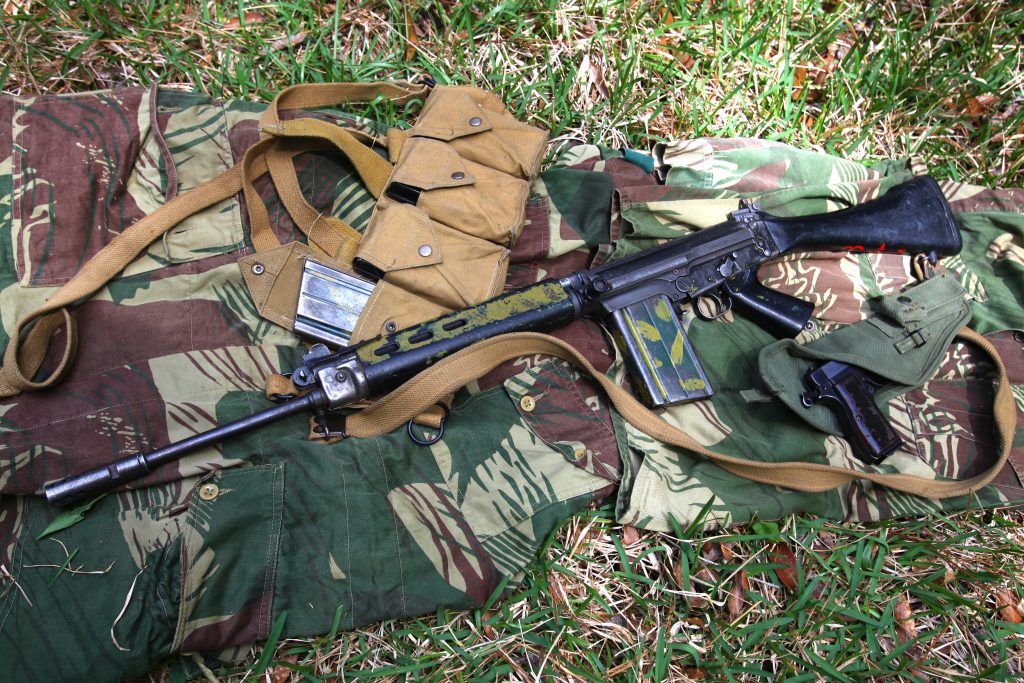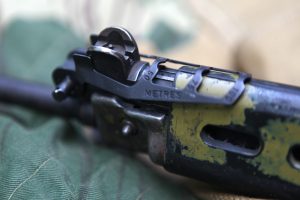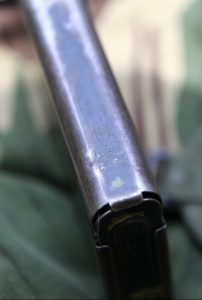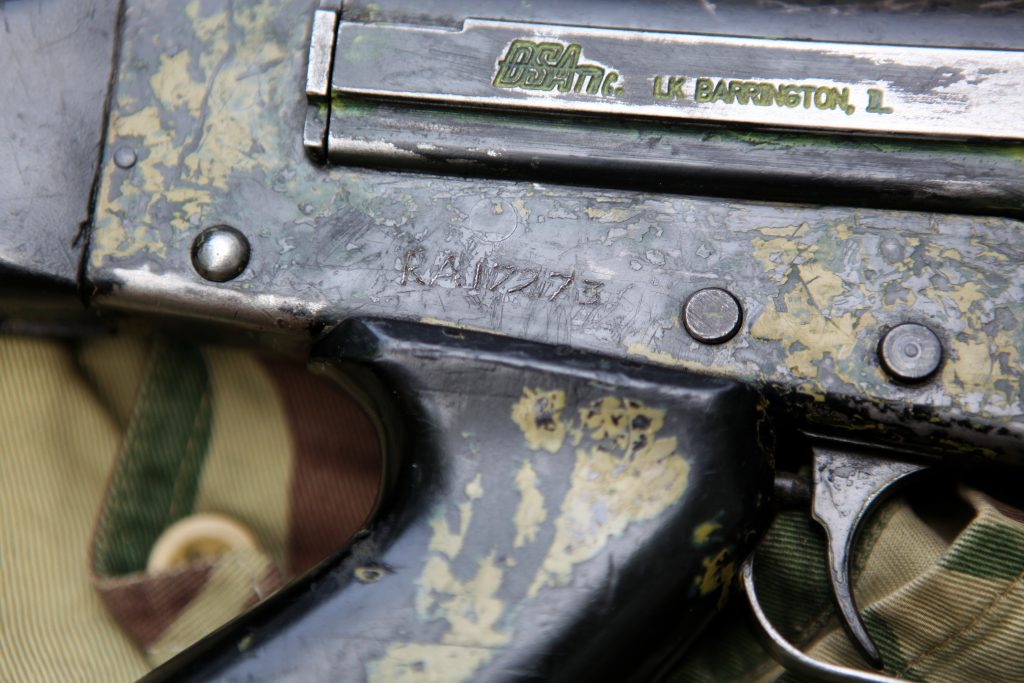Rhodesian FALs: A Brief History and How to Spot One in the Wild

A typical Rhodesian service rifle, battered and bruised from the ages. Pictured here with a reproduction chest rig, original side arm and original holster. Photo by Rande Archer
The Fabrique Nationale d’Herstal FAL (Fusil Automatique Léger) was the backbone of the Rhodesian Army during the Bush Wars. Highly regarded by troops for its ease of use, accuracy, quality, and strength, it is also considered one of the most iconic firearms used by the doomed African nation. Today they are highly sought after for their war used pedigree, field applied camouflage aptly named “baby poop,” and ragged looks, fetching prices well above what they were a few years ago. But before we can discuss the current market and affairs with these rifles we should dive briefly into the history of these war horses.

Although an iconic rifle feature, the Rhodesian baby poop was actually left over aviation paint that was used to camouflage the Rhodesian Air Force. Photo by Rande Archer
Back when Rhodesia first became an independent nation, arms embargoes were in place to prevent them from acquiring newer firearms. This led to a situation that forced Rhodesia to pursue alternative ways in acquiring firearms. In addition to their inherited weapons Rhodesia acquired a wide variety of second-hand firearms as well as some Com-bloc items through backdoor deals. Some of the first FALs to be brought into Rhodesia via these shady deals for instance were a large number of ex-German Bundeswehr issue G1 rifles. Often mistaken by collectors as Austrian STG-58s, the markings and serial numbers were all consistent with the serial ranges of G1s sold as surplus by the German government to the Portuguese government and there is no evidence that the Rhodesians ever got their hands on STGs. Other FAL variants that were brought into the country were early FN produced FALs, South African produced R1s, and in some rare instances there were L1A1s of both British and Australian origin in service.

A common feature on most Rhodesian rifles is a holdover from the South African R1s they received: Grenade Sights. Photo by Rande Archer
Once received into service, the Rhodesians marked their weapons with their own serial numbers. These electrostenciled serial numbers with a “RA” prefix help show that the parts were in Rhodesian Army service. The FALs were marked in the following locations: the bolt, the bolt carrier, the upper receiver (not available for sale in the United States due to the ATF ruling that “once a machine gun, always machine gun.” It is not known if a Rhodesian FAL made it on the registry), and the lower receiver. The barrels were not serialized and magazines were marked in a special way, more on that later. It should be noted that after Rhodesia became Zimbabwe the FAL was briefly the standard issue rifle, these were marked in a similar fashion with electrostenciling with a “ZA” prefix instead of “RA.” Most Mugabe era FALs were painted brown and were new-at-the-time purchase Imbels bought directly from Brazil.
Another feature unique to Rhodesian FALs was the act of “sanitizing” their South African R1s. In case of a weapon being captured by the communists and eventually shown to the United Nations as proof of Rhodesia receiving new weapons, the Rhodesians would sanitize their R1s since they were marked with South African factory markings on the lowers and uppers which were a M inside of an U. This sanitizing involved either lightly drilling into where the stamps are, which left a dimple like spot, or they just took a drill and drilled through the whole thing, leaving no trace of the stamp at all on both the upper and lower. This feature is often replicated on reproduction rifles and clones. Another example of sanitizing was found on the new R1 magazines with South African markings, which the Rhodesians would lightly drill or sand them to remove the M in U marking, leaving a dimple or scratched out region. Since the German G1s and Belgian produced FALs were second-hand rifles unlike the minty fresh South African factory rifles, there wasn’t any sanitizing done to them.

Sometimes markings will go untouched due to their odd locations, like this South African factory code, acceptance stamp and date code left intact on a magazine. Photo by Rande Archer
Now the most recognizable and most iconic feature of a Rhodesian FAL is it’s camouflage. However the rifles weren’t always painted like that, the Rhodesians initially painted their rifles black with baked enamel paint, however this led to their soldiers being spotted from afar as long black sticks stood out against camouflage patterns. After a lovely chat with a lad who was captured during a Fireforce operation, the Rhodesians started slapping leftover aviation paint that resembled an angry 6 month old baby’s fecal discharge and some forest green paint on their webbing and rifles so that it would break up their outline. Other features indicative of Rhodesian service was the removal of the carry handle and rear sling swivel from general service. The order to remove carry handles allegedly came after an encounter with insurgents where during the firefight a Rhodesian soldier had the unlucky circumstance of having an ejected brass casing deflect off of his partially extended carry handle and land in his eye, blinding him. A story for the slings was told that they didn’t want the slings getting caught on foliage out in the bush, and it was just easier to remove the slings from general use. However there are many documented cases throughout the war of soldiers using both slings and carry handles.

Although removed from general service, slings and carry handles still saw use in special units such as the Rhodesian Special Air Service, Selous Scouts, and Grey’s Scouts. A popular sling to use for them was the vintage World War Two issue Bren sling, as it was longer than a standard issue sling. Photo by Rande Archer
Now comes the question “Where can I find one of these?” Well, there’s good news and bad news. Good news is there are still parts kits and parts floating around that can be used to build yourself a Rhodesian FAL. Bad news is, they are on the way out. Supply has dried up over the years, as they were briefly imported as kits back in 2003 (for a low price of $150 back then too!). This means prices will be absurd for what they are, rough condition kits with lots of rust and pitting. The best thing to do for this is to keep an eye on Gunbroker (keep an eye out for “South African kit” as these sometimes get listed as South African) for parts kits and parts builds (which pop up sometimes, but most are refinished), and for Armslist for parts builds. The average price for a complete kit has been between 800$ and 1,300$, when they do show up. Add in the price of a receiver of your choice and you’re looking at anywhere between 1,300$ to 1,800$ total for a Rhodesian kit build either built yourself or found online. The degree of difficulty for building one on your own is harder than an AR-15 but easier than an AK. They just require special tools, and a solid vice. Just be sure to keep an out out for those RA serials and you too can one day own a piece of Bush War history.






Police force (BSA Police) was also issued with SA R1s in the early 70’s. They were engraved with the serial number on the right hand side of the stock and on top of the “mouse” (shell extractor). Mine was 8796. A number I have never forgotten. Piece was permanently issued to the recruit in training and stayed with him until discharge, however long that was. Mine was out of the box and factory black on issue and through Op Thrasher but was camo painted when I moved down to Op Tangent/Repulse. Enjoyed reading your article – thanks.
Sorry, I mean right hand side of the butt not the stock (senior moment !)
For those of you who are interested in the Rhodesian war, here’s a book for you, written by an ex Rhodesian soldier : BRIDGE TO NO RETURN : Amazon.com
great to read the “snippits” Im 72yrs old now, served in Mike Hoar unit 5 Commando Albertville-Baraka-Fizi , (just turned 17yrs at the time 2nd youngest) Rhodesian {PATU only 5 others who started it off 1964, Fireman on the footplate Bulawayo, Prisons service Salisbury, Minining, Mangula,/Sinoia,Rhodesia , England Oil/grain broker Kedros shipping, Carpenter.Joiner. Building Manager, Senior Construction manager Canary Wharf. plus multi million buildings London.
Retired now and having a good giggle on what Im reading…..Heh heh just keep them coming
Ive earned medals and at the end of the day they are only worth what you have done and no more
Amazing, sir. Thank you very much for your service.
Hi Liam, very interested to read that you served with 5 Commando in the Congo. I have been researching and collecting Congo Mercenary badges, uniform items, photos, documents and medals awarded to 5 Cmdo soldiers who either served before the Congo or afterwards. I was around 12 or 13 when I met Johnny Hoy, a friend of my father, who had been Mike Hoare’s driver and was wounded, shot through his thigh and is mention in Mike Hoare’s book, Congo Mercenary. I had already been collecting military medals, badges, etc, when I met him, but that got me interested in the Congo items as well. One of the chaps whose medals I have in my collection, Commandant Hugh van Oppen, was murdered in the Congo, with his own Tommy Gun. I also have a lot of documents, orders, letters, etc, that was sent to his brother after Hugh was killed, and in one of the documents a 2nd Lieut M.J.Cronly-Dillon, is that a brother of yours? I also collect and research Rhodesian medals and have an L.Cronly-Dillon, who served in the Rhodesian 8 Signal Squadron, on a Pay Roll dated May 1980. Is he your son? From his force number I can see he joined either very late 1979 or early 1980. Looking forward to hearing from you, please email me on militaria at netpoint dot co dot za Kind regards, James MacKenzie
A stenciled “ZA” is Zimbabwean? I thought the stamped “ZA” was Zimbabwean, and a stenciled one was Zambia?